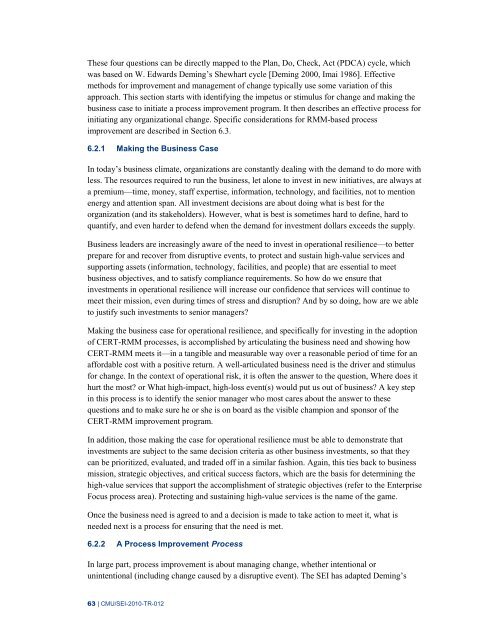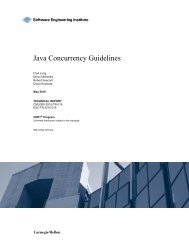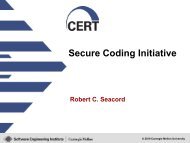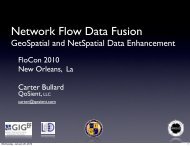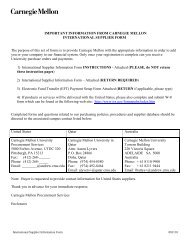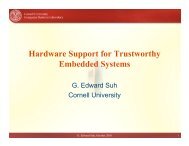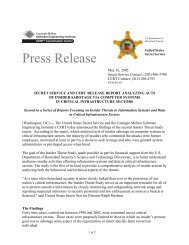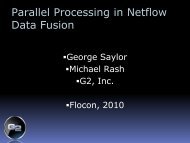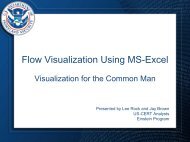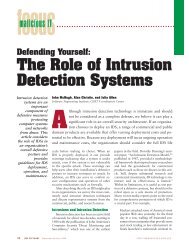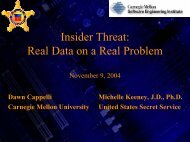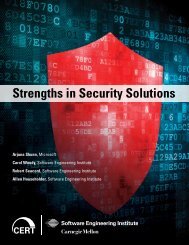CERT Resilience Management Model, Version 1.0
CERT Resilience Management Model, Version 1.0
CERT Resilience Management Model, Version 1.0
- No tags were found...
You also want an ePaper? Increase the reach of your titles
YUMPU automatically turns print PDFs into web optimized ePapers that Google loves.
These four questions can be directly mapped to the Plan, Do, Check, Act (PDCA) cycle, whichwas based on W. Edwards Deming’s Shewhart cycle [Deming 2000, Imai 1986]. Effectivemethods for improvement and management of change typically use some variation of thisapproach. This section starts with identifying the impetus or stimulus for change and making thebusiness case to initiate a process improvement program. It then describes an effective process forinitiating any organizational change. Specific considerations for RMM-based processimprovement are described in Section 6.3.6.2.1 Making the Business CaseIn today’s business climate, organizations are constantly dealing with the demand to do more withless. The resources required to run the business, let alone to invest in new initiatives, are always ata premium—time, money, staff expertise, information, technology, and facilities, not to mentionenergy and attention span. All investment decisions are about doing what is best for theorganization (and its stakeholders). However, what is best is sometimes hard to define, hard toquantify, and even harder to defend when the demand for investment dollars exceeds the supply.Business leaders are increasingly aware of the need to invest in operational resilience—to betterprepare for and recover from disruptive events, to protect and sustain high-value services andsupporting assets (information, technology, facilities, and people) that are essential to meetbusiness objectives, and to satisfy compliance requirements. So how do we ensure thatinvestments in operational resilience will increase our confidence that services will continue tomeet their mission, even during times of stress and disruption? And by so doing, how are we ableto justify such investments to senior managers?Making the business case for operational resilience, and specifically for investing in the adoptionof <strong>CERT</strong>-RMM processes, is accomplished by articulating the business need and showing how<strong>CERT</strong>-RMM meets it—in a tangible and measurable way over a reasonable period of time for anaffordable cost with a positive return. A well-articulated business need is the driver and stimulusfor change. In the context of operational risk, it is often the answer to the question, Where does ithurt the most? or What high-impact, high-loss event(s) would put us out of business? A key stepin this process is to identify the senior manager who most cares about the answer to thesequestions and to make sure he or she is on board as the visible champion and sponsor of the<strong>CERT</strong>-RMM improvement program.In addition, those making the case for operational resilience must be able to demonstrate thatinvestments are subject to the same decision criteria as other business investments, so that theycan be prioritized, evaluated, and traded off in a similar fashion. Again, this ties back to businessmission, strategic objectives, and critical success factors, which are the basis for determining thehigh-value services that support the accomplishment of strategic objectives (refer to the EnterpriseFocus process area). Protecting and sustaining high-value services is the name of the game.Once the business need is agreed to and a decision is made to take action to meet it, what isneeded next is a process for ensuring that the need is met.6.2.2 A Process Improvement ProcessIn large part, process improvement is about managing change, whether intentional orunintentional (including change caused by a disruptive event). The SEI has adapted Deming’s63 | CMU/SEI-2010-TR-012


